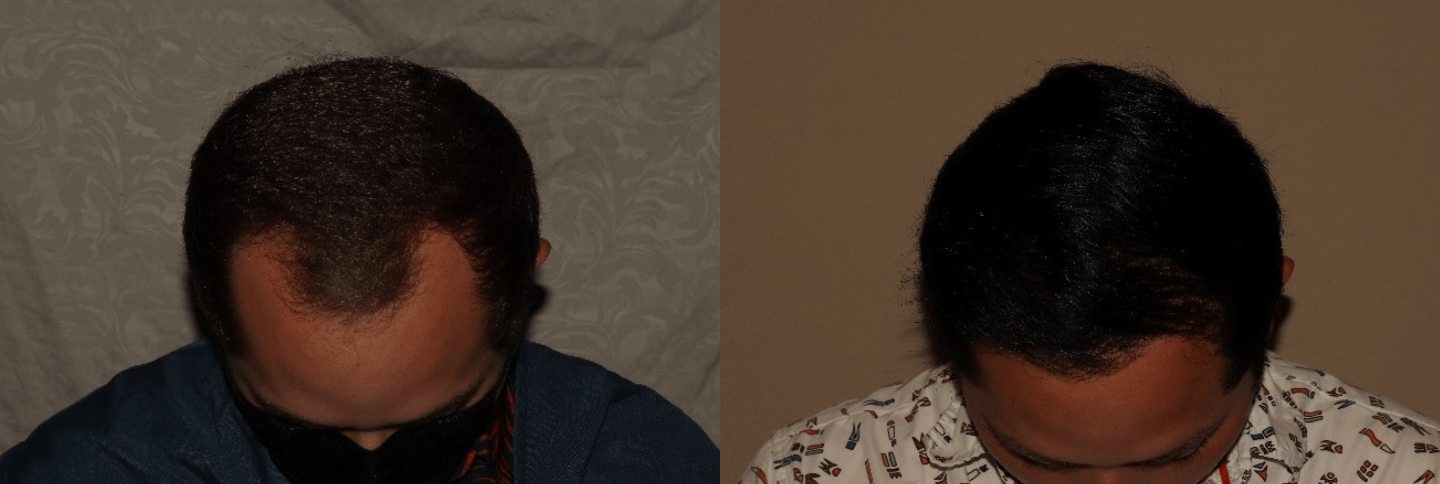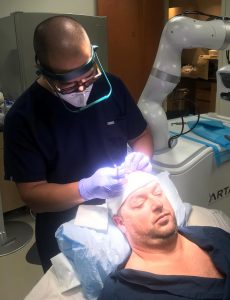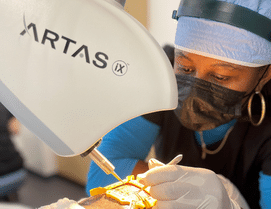
You’re definitely not alone if you’re experiencing hair loss – it’s a common issue that affects millions of people worldwide. While many remedies and treatments are available for hair loss, hair transplant surgery has become increasingly popular in recent years to restore a receding hairline, fill in bald spots, or provide a denser look to areas of thinning hair. However, several myths and misconceptions surrounding hair transplant surgery can discourage people from considering this option. In this article, we will debunk the most common hair transplant myths to help you make an informed decision about your hair restoration options.
 One of the biggest misconceptions about hair transplant surgery is that it is a painful procedure. However, the truth is that hair transplant surgery is performed under local anesthesia, so the scalp is numbed, and patients do not feel any pain during the procedure. At The Lumen Center, we use only Follicular Unit Extraction (FUE) methods with the ARTAS iX Robotic Device and NeoGraft Hair Transplantation System, which are both minimally invasive and result in little to no pain or scarring. After the surgery, some discomfort and swelling may occur, but this can be easily managed with pain medication and subsides in a few days.
One of the biggest misconceptions about hair transplant surgery is that it is a painful procedure. However, the truth is that hair transplant surgery is performed under local anesthesia, so the scalp is numbed, and patients do not feel any pain during the procedure. At The Lumen Center, we use only Follicular Unit Extraction (FUE) methods with the ARTAS iX Robotic Device and NeoGraft Hair Transplantation System, which are both minimally invasive and result in little to no pain or scarring. After the surgery, some discomfort and swelling may occur, but this can be easily managed with pain medication and subsides in a few days.
Although male pattern baldness is more common, women can also experience hair loss. Among other therapies, hair transplant surgery can be an effective solution for both men and women.
Hair transplant surgery is a rewarding but long game, and you should not expect immediate results. After the procedure, the transplanted hair falls out and regrows – a normal part of the process. It takes several months to see new hair growth, and it can take up to one year to see full results. Many patients don’t mind that the hair regrowth process is gradual – it’s not as noticeable or apparent that they had a hair transplant surgery. It’s well worth the wait because the results are excellent.
We firmly believe that a hair transplant is an investment and one aspect of a holistic hair restoration plan. Maintenance is key and we highly recommend platelet-rich plasma (PRP) therapy during and after your hair transplant to help your follicles survive in their new location. Studies of PRP show positive outcomes to help slow and even stop shedding, along with medications such as minoxidil. Some patients opt for one approach over another, and some use both PRP and medications to protect their investment. These are excellent maintenance tools to slow or stop the shedding.
Not so! Hair transplant results are permanent. The transplanted hair follicles are taken from the donor area (usually the back of the scalp) where hair loss is less likely to occur. Once transplanted, these follicles continue to grow hair and thrive in their new location.
If you think hair transplants look like hair plugs, think again. Thanks to advancements in technology and techniques, modern hair transplant surgery can achieve undetectable, natural-looking results that blend seamlessly with your existing hair.
Artistry is key during the hairline design at LUMEN to achieve a natural look. Our skilled surgeon creates an age-appropriate hairline that balances your facial structure and features. It’s not as easy as moving hair from the back of the head and implanting it at the top. We take great care in the graft placement, focusing on the direction of the hair and spacing the grafts so that the proper density can be achieved.
Before and after of a hair transplant at The Lumen Center.
View the gallery
Getting a hair transplant will not cure hair loss. While the transplanted hair follicles are permanent, you may have new areas of loss or thinning in the future. Other therapies and medications for hair loss, including PRP and nanofat injections, can help prevent further hair loss.
We consider many factors when determining the number of hair follicles we can safely transplant. More is not necessarily better. And too many may risk the follicle survival rate and result in less-than-ideal placements. Our goal is to make your hair transplant look as natural as possible based on your hair loss pattern, facial features, desired density, and goals. Once we determine if you’re a candidate, we will discuss how many grafts would be appropriate.
Hair transplants are a balancing act when it comes to hair loss. You don’t want to have a hair transplant too early when you don’t yet know the pattern of the hair loss or for it to not substantially change your appearance. You also don’t want to wait until hair loss is so advanced that there aren’t enough follicles to transplant. In general, most men between 28 and 55 receive hair transplants, but it varies based on the extent of hair loss. A hair transplant can be considered as long as you have sufficiently healthy hair follicles to transplant, and they provide enough coverage to the recipient area.
Your hair transplant is 100% customized to meet your individual needs and goals. At LUMEN, we recognize that hair loss is different for everyone, and not every hairline is the same. Hair transplants are customized based on a variety of factors, such as hair type, age, degree of hair loss, how much density you desire, and how you wear/style your hair.
 Usually, hair transplants are successful, which is why they are popular. However, that doesn’t mean all the transplanted follicles will survive and grow hair. It requires a highly skilled team who takes great care, attention, and time to ensure the follicles are implanted correctly. It’s easy to damage the follicles, or if they are separated from the body for too long, they won’t survive. That’s why we never rush this intricate process at LUMEN and examine each graft under a microscope to determine its viability. And it’s why our follicle survival rate is so high – 96-98% depending on the device.
Usually, hair transplants are successful, which is why they are popular. However, that doesn’t mean all the transplanted follicles will survive and grow hair. It requires a highly skilled team who takes great care, attention, and time to ensure the follicles are implanted correctly. It’s easy to damage the follicles, or if they are separated from the body for too long, they won’t survive. That’s why we never rush this intricate process at LUMEN and examine each graft under a microscope to determine its viability. And it’s why our follicle survival rate is so high – 96-98% depending on the device.
At LUMEN, we agree with the adage that “haste makes waste.” It’s the reason we take our time, and our team is meticulous in getting you the best results. On the day of your hair transplant procedure, we’re 100% focused on you and don’t schedule other hair transplant procedures that day. Usually, hair transplants take 8-10 hours to get the achieve the best results. (Patients are comfortable the entire time and can relax and watch a movie.)
By debunking these common myths, we hope you have a more accurate understanding of hair transplant surgery so it can help you decide about your hair loss treatment options. With the right surgeon and realistic expectations, a hair transplant can provide natural-looking results that boost your confidence and help you look and feel your very best.
What else have you heard about hair transplants, and what questions do you have? We’re here to answer them and help you separate fact from fiction at a complimentary consultation. Schedule yours today or call us at 610.525.0606 to see if you’re a candidate for a hair transplant.

Sandra brings over 15 years of healthcare expertise to her role as a marketing writer, where she specializes in turning medical information into easy-to-understand content. Outside of work, she enjoys hiking with her family and reading.